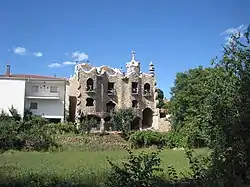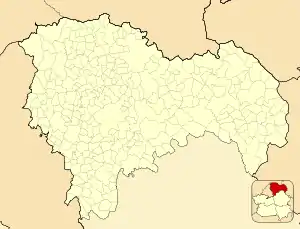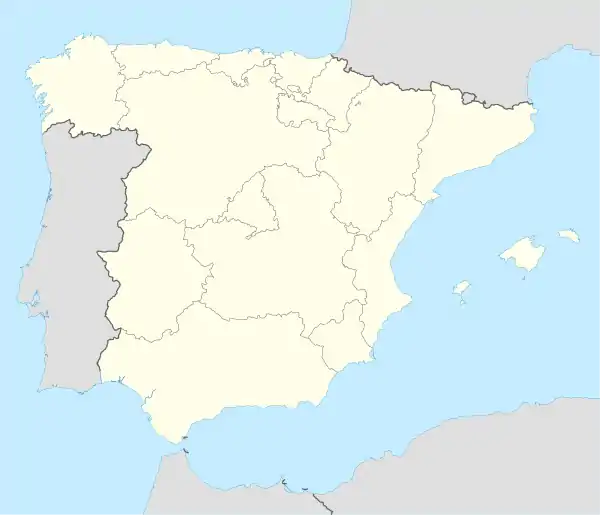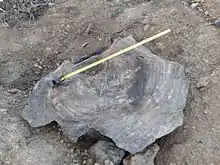Rillo de Gallo
Rillo de Gallo is a municipality located in the province of Guadalajara, Castile-La Mancha, Spain. According to the 2004 census (INE), the municipality has a population of 74 inhabitants.
Rillo de Gallo, Spain | |
|---|---|
 | |
 Rillo de Gallo, Spain  Rillo de Gallo, Spain  Rillo de Gallo, Spain | |
| Coordinates: | |
| Country | |
| Autonomous community | Castile-La Mancha |
| Province | Guadalajara |
| Municipality | Rillo de Gallo |
| Area | |
| • Total | 25 km2 (10 sq mi) |
| Population (2018)[1] | |
| • Total | 44 |
| • Density | 1.8/km2 (4.6/sq mi) |
| Time zone | UTC+1 (CET) |
| • Summer (DST) | UTC+2 (CEST) |
Symbols
The heraldic shield of the municipality of Rillo de Gallo was approved by Decree 138/87, of October 27, of the Community of Castilla-La Mancha. Half-split and cut shield. First, from azur the golden rooster. Second, silver the tree, elm of sinople. Third, of azur ax of silver. At the buzzer, royal crown closed.
Geography
The town of Rillo de Gallo is located at an altitude of 1,055 meters above sea level and at the maximum altitude of its municipality is located in the loma de Matillas at 1,404 meters of altitude.
The municipality of Rillo de Gallo borders on the north with Pardos and Torrubia, on the south with Corduente, on the east with Rueda de la Sierra and with Molina de Aragón and to the west with Herrería
The Gallo river, which gives the town its name, passes far from the urban area, although it irrigates its lands. The fluvial courses that pass through the urban helmet are the Viejo river, the Herrería river or of the Viejo and the Seco river.
Geology
In the area where Rillo de Gallo is located, there are important geological s and geomorphological s essential values in the area that have given rise to its proposal as an internationally recognized Geosite. On the one hand, a «fossil forest» of the Permian with numerous specimens in position of life and with volcanoclastic rocks and lacustrine s of the same age associated with it

Numerous geological formations with remains fossil are also represented Permian and the Triassic of Western Europe, important for their content in macroflora, associations palynological, ichnofauna of vertebrates and facies marinas with Middle Triassic fauna well conserved. In addition, it has been possible to establish the only continuous magnostratigraphic scale for the Permian and Triassic of the Iberian Peninsula. As well as detritic units of the Late Triassic and part of the Middle Triassic, result of a great fluvial system of low sinuosity and bottom charge of gravel or of sand s of this age.[2]
The road from Rillo de Gallo to Pardos, next to the ravine of the Hoz del Río Gallo (Corduente), is proposed as « Global Geosite » (Place of interest Spanish Geological Survey of International Relevance) by the Instituto Geológico y Minero de España for its stratigraphic interest, with the denomination "MZ003: The Permian and Triassic of the Señorío de Molina" within the group of geological contexts «El rifting of Pangea and the Mesozoic successions of the Bética and Iberian mountain ranges'.[3]
History
Ancient historians say that the capital, Molina, was founded by the Romans, and built next to the nearby town of Rillo de Gallo, receiving the name of Manlia with which it appears in ancient Latin chronicles. The truth is that the city of Manlia was the head of a large Celtiberian territory, being it for centuries before the confederation of Numancia. Also the famous city of Ercávica has been placed in the territory of Molina, and identify it with its capital, and even the Celtiberian and then Romanized Lacóbriga has said that it was where today Labros, for the reasons given by the chroniclers of the Golden Age are , clearly, weak and not fundamental.
Rillo de Gallo was the first place in Spain to find a footprint of dinosaur. The discovery took place in the year 1896 when a local resident found "the stone foot of a bug , which the scholars of the time described as" a petrified leg of a corpulent animal "and that they identified with that of a Chirotherium .[4] The specimen is found in the Vertebrate and Prehistory Paleontology Collection of the National Museum of Natural Sciences. A sample of the evidence of the existence of reptiles in the fossil record are the traces of the Triassic, found in the Museo Geominero in Madrid.

Heritage
- The parochial church is a small building with espadaña to the west and simple semicircular door to the south, that remembers its medieval origins.
- The house of the marquises of Embid, of severe traditional lines, with magnificent baroque shield over the door; and in the center of the square the fountain dedicated as a monument to Calixto Rodríguez.
- The Capricho Rillano built by Juan Antonio Martínez on the edge of the road N-211 km 54, it is a modernist building that follows a model gaudiano. The house, built in stone, includes elements in forge and trencadís reminiscent of the work of the Catalan master. Perhaps its most prominent element is the serpent that falls from the roof over the entire height of the building, in reference to the legend collected in the XVII century by the Licentiate Francisco Núñez, and that includes the existence of a gigantic snake in the nearby dehesa of Villacabras, as tall as a man, who would have been sighted several times.
- El Abrigo del Llano (Rillo I and Rillo II) are two remains of cave paintings declared World Heritage by UNESCO in 1998 within the rock art of the Mediterranean arch of the Iberian peninsula (the only two in the province of Guadalajara) and Property of Cultural Interest since February 17, 1997.
Folklore and customs
Historically the parties were not celebrated in the month of August. The Fiesta, because they were not parties, was on September 8 (Nativity of the Virgin Mary), on the 9th the Fiestecilla and on the 10th the Abuela.
Gastronomy
The most outstanding gastronomy of the municipality is made up of sausages, among which the black pudding and chorizo stand out.
References
- Municipal Register of Spain 2018. National Statistics Institute.
- Resolution of July 29, 2004, from the Dirección General de Calidad Ambiental, on the declaration of environmental impact of the project called Parque Eólico Matillas y su Línea Eléctrica de Evacuación . (DOCM No. 154, of August 24, 2004, page 13844).
- Instituto Geológico y Minero de España (2011). "Spanish geological interest sites of international relevance (Geosites)" (PDF). Retrieved November 23, 2014.
- Minutes of the Spanish Society of Natural History (1897), pages 27 to 29.
External links
- Rillo de Gallo(in English)
- Rillo de Gallo(in Spanish)